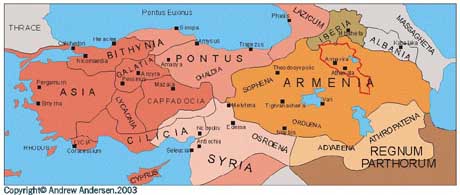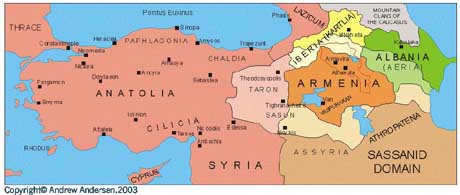Armenia
Early Armenia: 900 B.C.
- 500 A.D.
 The
earliest history of Armenia is full of mysteries and sounds
more like a legend than history proper. However, basing on
ancient Assyrian and Greek chronicles as well as on the Holy
Bible and the results of archeological research, we can
believe that the land later called “Armenia” was invaded by
the Hittites (ca. 2100 B.C.), Celts (ca. 1200 B.C.), Medes
and Persians (ca. 900 B.C.) and Cimmerians (714 B.C.). The
earliest history of Armenia is full of mysteries and sounds
more like a legend than history proper. However, basing on
ancient Assyrian and Greek chronicles as well as on the Holy
Bible and the results of archeological research, we can
believe that the land later called “Armenia” was invaded by
the Hittites (ca. 2100 B.C.), Celts (ca. 1200 B.C.), Medes
and Persians (ca. 900 B.C.) and Cimmerians (714 B.C.).
We also know that
in the 9th century B.C. most of the territory of the future
Armenia was occupied by the kingdom of Urartu which, in its
turn was later absorbed by the Assyrian empire.
Urartu was often called the "Kingdom of
Ararat or, in Assyrian, Urartu". Its native name was
Biainele, in many ancient manuscripts and holy writings of
different nations. The reason for uncertainty in the names (i.e.
Urartu and Ararat) is due to variations in sources. The
documented history of Urartu begins in 1275 BC, and ends
early in the sixth century BC.
In fact, the written
languages at that time employed only consonants and not
vowels. So the word itself in various ancient sources is
written as "RRT", which could be either Ararat, or Urartu,
or Uruarti and so on.
Caucasus from the fall
of Babylon and Urartu To Assirian expansion c. 2000 to 600
BC. Major ethnic movements c. 2100 to 710 BC

 |
Hittites c. 2100
BC |
 |
Celts (Phrygians,
Mushki) c. 1200 BC |
 |
Medes and
Persians c.900 BC |
 |
Cimmerians c. 714
BC |
 |
Major tribes of
the area |
 |
First known
states of the area |
|
Between 558 and 334 B.C.
Armenia was part of ancient Persian empire and by 323 B.C.
was conquered by Alexander the Great.
In early 2nd
century B.C., first known Armenian kingdom was born to
become an arena of long and devastating conflicts between
major local powers Rome and Parthia.
Early Armenian State
and the Peak of its Might: 189 - 63 BC

 |
Kingdom of
Armenia ca. 189 BC |
 |
Kingdom of Pontus
ca. 160 BS |
 |
Poman Possessions
(Provinces and Client Sates) ca. 90 BC |
 |
Armenian Conquest
187-70 BC |
 |
Conquest of
Pontus 120-63 BC |
 |
Kingdom of
Armenia ca. 70 BS |
 |
Modern Armenia |
Ancient Armenian kingdom
came to the peak of its might between 189 and 63 B.C. during
the reign of Tighran the Great who became an ally of
Mithridate VI Eupator of Pontus in his fight against Rome.
Between 187 and 70 B.C., Armenian state expanded greatly at
the expense of Rome, Parthia, Iberia and Albania stretching
from South Caspian seashore to the Mediterranean coast of
Syria.
Decline of Armenia: 65
- 115 AD

 |
Kingdom of
Armenia CA.70 BC |
 |
Lost by Armenia
to Rome by 65 BC |
 |
Lost by Armenia
to Parthia by 65 BC |
 |
Other Roman
Conquests by 65 BC |
 |
Kingdom of
Armenia (Rom. & Parth. Dep.) 65 BC - 115 AD |
 |
Roman Possesions
(Provinces and Client States) ca. 60 BC |
 |
Modern Armenia |
However, the Greater
Armenian empire of Tighran did not last long. As a result of
successful Roman campaigns of Pompeus from the west and
Parthian invasion from the south, Armenia lost some of her
conquests by 65 B.C.
and in fact became Roman-Parthian dependency.
Further Decline of
Armenia: 117 - 600 AD

The following 600 years of
Armenian history were marked by long wars against Rome and
Parthia (Iran) as well as further territorial decline.
NB:
In the year 301 Armenian King Thiradates III adopted
Christianity as the state religion thus
making Armenia the first Christian nation of the world.
Copyright © 1996-2005
Atlas of Conflicts, Andrew Andersen. All rights reserved. |

